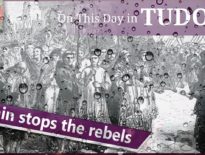Today, 25th October, is a feast day which was celebrated in medieval and Tudor times - the feast of Saints Crispin and Crispinian, martyrs of the Early Church and the patron saints of cobblers.
Find out more about these saints, how their feast day became linked to an important English victory over the French, how it was marked, and why these saints are linked to Faversham in Kent, in today's talk.
Also on this day in Tudor history, 25th October 1532, Henry VIII returned to Calais following his visit to the French court at Boulogne, and he took the French king, Francis I, with him. But first, Francis I wanted to honour two English noblemen by making them Knights of the Order of St Michel. After that ceremony, the two kings travelled on to Calais, where they were greeted in a spectacular fashion, and Francis I sent Henry VIII's sweetheart, Anne Boleyn, Marquess of Pembroke, a rather splendid gift. Find out all about this day in 1532 in last year’s video:
The St Crispin Day speeches from "Henry V":
Also on this day in history:
- 1529 - Sir Thomas More became Henry VIII’s Lord Chancellor.
- 1536 – Four Chaplains of Poverty were appointed by the Pilgrimage of Grace rebels: Barnard Townley (Chancellor to the Bishop of Carlisle and Rector of Caldbeck), Christopher Blenkow (Vicar of Edenhall), Christopher Slee (Vicar of Castle Sowerby) and pluralist Roland Threlkeld. The rebels threatened them with execution if they failed in their duty, which was “to instruct the commons ‘concerning faith’”. Also on this day in 1536, and the following day, a special mass, called the Captains’ Mass was performed at Penrith Church.
- 1555 – A worn out Charles V abdicated a number of his titles, giving his son Philip control of the Low Countries.
- 1557 – Death of Sir William Cavendish, courtier, privy Councillor and administrator. Cavendish served Henry VIII as a Visitor of the Monasteries, in the Exchequer and as Treasurer of the Chamber, a post which he also held in Edward VI's reign. Cavendish married Bess of Hardwick in 1547.
- 1558 – Death of John Bird, Bishop of Chester, at Great Dunmow, Essex. He was buried there, in his own church. Bird was deprived of his see when Mary I came to the throne, due to his marriage, but was able to become Vicar of Great Dunmow after setting aside his wife.
Transcript:
Today, 25th October, is a feast day which was celebrated in medieval and Tudor times - the feast of Saints Crispin and Crispinian, martyrs of the Early Church. These men were brothers, and perhaps twins, from a noble Roman family. It is said that they travelled to Soissons in France, fleeing from persecution, and that on their travels they supported themselves as cobblers while converting people to the Christian faith.
The brothers were apprehended, tortured and then millstones were tied around their necks and they were thrown into a river on the orders of the Roman Governor Rictius Varus. They survived their ordeal only to be beheaded on 25 October 285 or 286 during the reign of Diocletian. A church was built in their honour in Soissons in the 6th century. According to an old local legend recounted by Thomas Deloney in his 1598 work “The Gentle Craft”, written in praise of shoemakers, the brothers were actually sons of a British prince who was executed by Emperor Carausius. Their widowed mother, fearing for her sons’ safety, made them flee their home in Canterbury, in Kent. They set off in disguise along the Roman road to London and stopped at Faversham, where they noticed a shoemaker’s premises. The workers there were so happy in their work that the brothers decided to settle there and work as apprentices. They eventually opened their own shoemaker’s shop in Faversham, where they lived for the rest of their lives, making shoes. In Faversham, there is a plaque on the Swan pub which reads “Near to this house dwelt Saints Crispin and Crispianus, the patron saints of bootmakers. The well to which the pump is connected is St Crispin’s Well”. Now, this is only a legend, and it’s not quite as dramatic as the other story, but interesting never the less.
In the 15th century, following the victory of England over France at the Battle of Agincourt, on the Feast of St Crispin and Crispinian, 25 October 1415, the day also became a celebration of the victory. Celebrations included bonfires, revelry and the crowning of a King Crispin.
Elizabethan actor and playwright, William Shakespeare, in his play “Henry V”, included a special St Crispin’s Day speech on the eve of the Battle of Agincourt. In this speech, the English king, Henry V,roused his men, who were vastly outnumbered by their French counterparts, to fight, pointing out “The fewer men, the greater share of honour”, and saying the famous words “We few, we happy few, we band of brothers;”
As well as being the patron saints of cobblers, St Crispin and St Crispinian are the patron saints of saddlers and tanners.
I’ll give you links to Kenneth Branagh’s wonderful rendition of the St Crispin Day’s speech from Henry V, as well as that of Laurence Olivier.



Leave a Reply